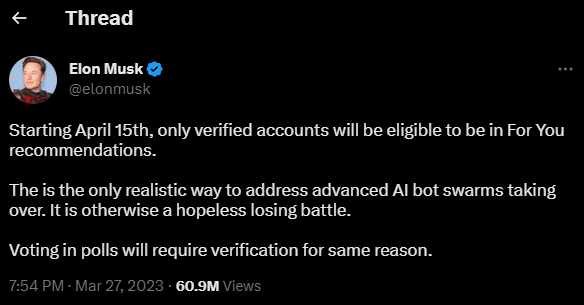Twitter owner Elon Musk’s latest scheme to address “bot swarms” make money is to limit the platform’s ‘For You’ page to verified accounts.
In a tweet (it’s always a tweet), Musk said that the change would come into effect on April 15th. Along with limiting For You recommendations to verified accounts, Twitter will also limit voting in polls to verified accounts.
Verified, in this case, refers to accounts subscribed to Twitter’s ‘Blue’ service, a system that hands out the blue checkmark verification symbol to anyone who pays. It was a controversial change from the old verification system that, while not perfect, was actually a useful way of determining whether an account was authentic. (That system is supposedly going away on April 1st, though Musk has been talking about killing off legacy verified for months). Government and company accounts should also count as verified, though companies need to fork out $1,000 per month for it.

A screenshot of Musk’s tweet, since he has a tendency to delete things. You can find it here while it remains available.
Though Twitter has toyed with the idea of adding government ID-based verification, at the time of writing, the company hasn’t actually done so. At this point, anyone with a phone number and credit card can get a Blue verified Twitter account. Moreover, ID-based verification would still be tied to Blue, meaning users would need to pay for the privilege of giving Musk more of their personal data.
Per Musk’s tweet, all this is in an effort to “address advanced AI bot swarms taking over.” However, if Twitter isn’t performing real verification of users, it’s not going to solve the bot problem Musk keeps talking about.
Besides, Musk acknowledged in a follow-up tweet that verified bots were fine as long as they followed the rules and didn’t impersonate people. In other words, Musk doesn’t have a problem with bots on Twitter as long as he can make money off them.
And really, that’s what this whole thing is — another way to try and wring cash out of the platform. After all, Musk just admitted that Twitter’s value has dropped to half of what he paid for it (and Musk previously said he overpaid for Twitter).
Coupled with Twitter’s recent security issues and other problems, it seems like a really bad idea to pay for any part of the service, no matter how badly you want your tweets to show up on the For You page. But if you really want to make a monthly donation to Musk pay for Twitter Blue, it costs $10/mo or $105/year on the web or $15/mo or $154.99/year on iOS and Android.
Image credit: Shutterstock



